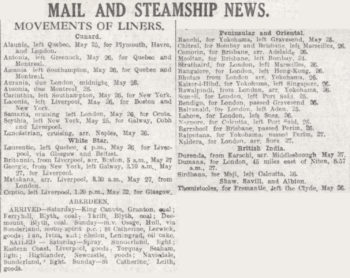
Passenger liners were regularly criss-crossing the globe in the early 20th century – the British Empire on which the sun never set was still very much a thing. When you traveled from India to London or Australia to London, you didn’t go directly, either “calling” at a port to transfer mail and goods, or staying a couple of days before continuing the journey.
I started looking at newspaper accounts of voyages when I wanted to know a departure date – passenger lists had the arrival date and the port at which a passenger boarded, but not dates. What I saw was daily coverage of the movements of mail ships, liners and other traffic in newspapers around the UK – not just in the port cities.
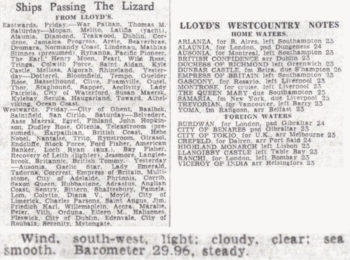
These lists stopped around the start of WWIII and were irrelevant thereafter, but provided fascinating insight into both getting or sending a letter or package then, plus the role of local newspapers for practical aspects of daily life, not just politics, sports and “celebrities”.
This world had its own lovely terminology – such as a headline “Ships Passing the Lizard” – and the tables with last times for mailing (to catch an outgoing ship) were massive matrices of places and routes.
If you note one of the items in the liner movements says “…45 miles east of Niton, 8.57a.m., 27.” Even though the news wouldn’t be read until the following morning, a sighting effectively saying the ship was in the home stretch, was worth noting. In a world of instant updates, that feels very strange. I had to look up Niton, but it’s where an important lighthouse on the Isle of Wight is located (see the map for voyages to track where everything is).
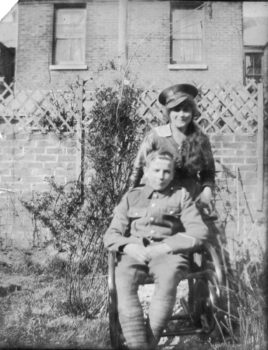
Some family were traveling the globe as part of military service – my great uncle Joe (Lt. Ernest Henry Williams, Jr. of the Royal Field Artillery) traveling back to England from India in 1934 with his wife and son. Some were emigrating to other parts of the empire (ignoring for a moment The Wastrel abandoning his family in 1910) as my great aunt Gwen did in 1918, sailing to Sydney Australia with her 3 year old daughter (turned 4 on the voyage) to rejoin her husband Jack who she hadn’t seen since March 1914. They married in Portsmouth in January 1914 and Jack left for Australia in March, probably unaware that Gwen was pregnant – Joan was born in December 1914).
My great aunt Emily Muriel – the Wastrel’s oldest child who taught English and never married – went to visit her sister Gwen in Australia in 1932. Gwen, Jack and family had returned to England for a visit in 1926 – the year my father was born – but that was the only time together they had as far as I know. Gwen had one more visit from UK family – in 1958, my grandparents went to Australia on the SS Iberia (a big splurge apparently as they traveled first class! Possibly the trip was to cheer Nanny up following major health problems in 1956 after I returned to my parents).
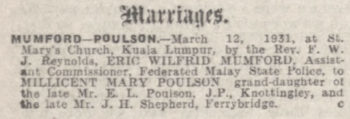 Another great aunt, Millicent Mary, was a nurse and went to what was then the Federated Malay States where she met an Englishman who was the Assistant Commissioner of the FMS Police. They married in Kuala Lumpur in 1931 and then traveled back and forth before Millicent and their two sons stayed in England during and after WWII. Both their sons were born in Seremham, Federated Malay States, but after the war, only Eric Mumford returned to Malaysia to assist in the emergency following a communist uprising.
Another great aunt, Millicent Mary, was a nurse and went to what was then the Federated Malay States where she met an Englishman who was the Assistant Commissioner of the FMS Police. They married in Kuala Lumpur in 1931 and then traveled back and forth before Millicent and their two sons stayed in England during and after WWII. Both their sons were born in Seremham, Federated Malay States, but after the war, only Eric Mumford returned to Malaysia to assist in the emergency following a communist uprising.
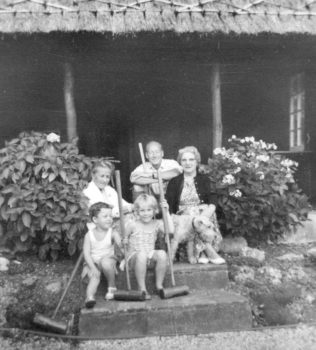
We didn’t know the Mumford’s well, but their son David was my brother Chris’ godfather and we had at least one visit to their home in England after all the travel was over. This garden near the New Forest in England seems to have a touch of their former home in Kuala Lumpur about it.
There’s some travel I know about, such as my grandfather’s army service in India between 1914 and 1920, but which I have no documentation or records for. I have to assume it was similar to, if less fancy than, the trips other family members took.
The time commitment for early 20th century long distance travel became clear in tracking the details of trips my great aunts and uncle took in 1926, 1932, 1934 and 1937. This wasn’t exploring, but world travel was by no means routine either – and that’s even more the case in the run up to World War II, with my great aunt Suzanne’s trip to Singapore in 1937 only a few months after the British had to be evacuated from Shanghai – in the ship she later sailed in – when the Japanese bombed it. In October, when she sailed, the SS Rajputana didn’t dock in Shanghai – that resumed in December. Reports of the evacuation said Navy gunboats shuttled people out to the ship while bombing continued!
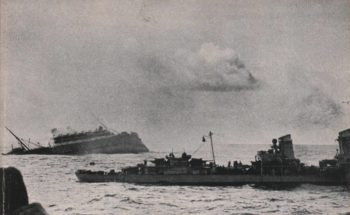
Only one of the ships for these trips, the Strathnaver, pictured above, survived the war – the rest were sunk as they provided support for military operations. The MV Dumana, SS Oronsay and SS Rajpuntana were all torpedoed. The HMS Rawalpindi was sunk in a fight with two German battle cruisers, and the RMS Orama shelled by the German heavy cruiser Admiral Hipper and finished off with torpedos. The SS Kashgar was broken up in 1932 – didn’t even get into the war!
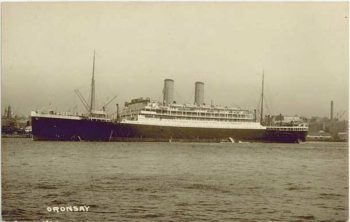
I was struck by the level of general interest in the movements of these mail ships in so many cities’ papers – daily columns of what was arriving/leaving/passing various ports – not only the cargo but mail was the focus, at least in the pre-World War II sailings. A letter took a long time to get to India or Australia or Malaysia by boat.
The notion of spending six weeks – each way – on just the travel part of a trip is hard to imagine today, but adjusting to time zone differences wasn’t an issue when you had a gradual enough adjustment the body could keep up. On the other hand, when people were away on a trip, you might not see them for years at a time.

After World War II, many things were different – empire was in decline, air travel and shipping in the ascendent and the pace of life made five month+ trips really hard for most people to do. The SS Iberia was a new ship – maiden voyage at the end of 1954 – and my grandparents went to see Gwen and family in Australia in 1958, leaving England in March and returning at the end of November.
 The look was a little updated from the earlier liners. I know nothing about the details of their trip of how much of Australia they saw (sadly) but it really must have a trip of a lifetime for them. Gwen was by then 67 and her oldest child Joan 44 – Gamps turned 61 during the trip. He was shown as “Retired” on the passenger list – perhaps a retirement present to themselves? I was back with my parents by then – but went with Dad and Aunty Jill to see Gamps and Nanny off. Only 3 years after they returned, Nanny died.
The look was a little updated from the earlier liners. I know nothing about the details of their trip of how much of Australia they saw (sadly) but it really must have a trip of a lifetime for them. Gwen was by then 67 and her oldest child Joan 44 – Gamps turned 61 during the trip. He was shown as “Retired” on the passenger list – perhaps a retirement present to themselves? I was back with my parents by then – but went with Dad and Aunty Jill to see Gamps and Nanny off. Only 3 years after they returned, Nanny died.
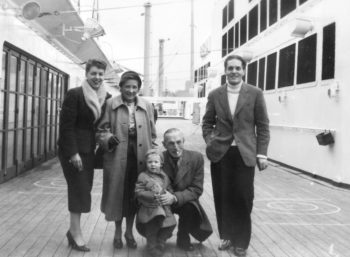
I don’t think Gamps left the UK again and the same goes for his sisters – except for Gwen who died in Australia in 1980. I’ve traveled more than they did in some ways – more often and to more countries. But less in others – these leisurely sailings around the world where life waits for you to get there.

